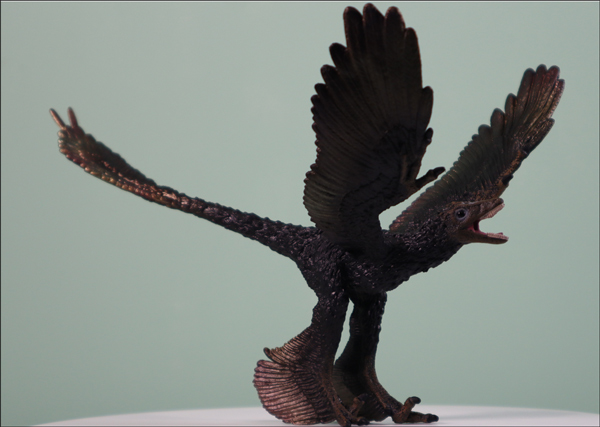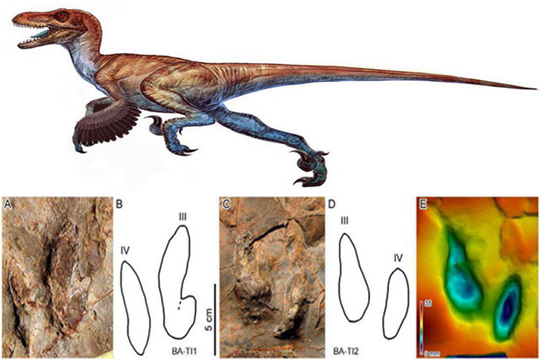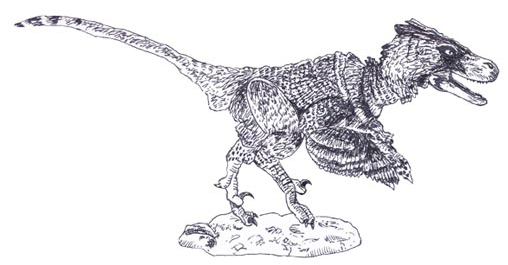New Research Highlights Feathered Dinosaurs from Iran
Tracksites Suggested Jurassic Troodontids in Iran
Iranian scientists in collaboration with researchers from China and the United States, have published details of a remarkable set of fossilised dinosaur footprints that provide tantalising evidence of the presence of fast-running, potentially feathered dinosaurs from the Middle Jurassic of Iran.
Troodontid-like Dinosaurs
The tell-tale, two-toed tracks are consistent with the sort of tracks associated with dinosaurs that are assigned to the Eumaniraptora clade (also referred to as the Paraves). Dinosaurs such as dromaeosaurids and troodontids are characterised by having an enlarged, sickle-shaped claw on the second toe of each foot. In a number of species, this claw is raised, so any footprints preserved, show just two toes in contact with ground (didactyl tracks), such tracks have been never been reported before from Iran and pre-Cretaceous tracks of this nature are exceptionally rare.
Evidence of Two-Toed Tracks from Iran – An Illustration of a Typical Dromaeosaurid Dinosaur
The picture above shows two of the tracks with accompanying line drawings and a digital analysis of track reference BA-T12 that shows the topographical outline of the track when transposed as a hyporelief print. A illustration of a typical Eumaniraptoran dinosaur running on just two toes of each foot is shown above the prints. Note the presence of feathers on the forearm in the illustration.
Didactyl Prints from the Middle Jurassic
Reporting in the academic journal “Historical Biology”, the researchers, which include Lida Xing (China University of Geosciences) and corresponding author Nasrollah Abbassi (University of Zanjan, Iran), along with Martin Lockley (University of Colorado), report the discovery of a small number of footprints preserved in sandstone from the Dansirit Formation in the Alborz Mountains (northern Iran). The sediments laid down in this area, close to the city of Baladeh, have been dated to the Middle Jurassic based on the extensive plant fossils that have been found in this locality.
As a number of fossils have been found elsewhere in the world, notably China, that reveal these types of dinosaurs to be feathered, it can be inferred that these Iranian dinosaurs too, might have had feathers. The scientists speculate that these tracks could have been made by a troodontid-like dinosaur.
Two-toed Dinosaur Tracks
Two-toed dinosaur trackways have been discovered at several sites, but as far as we at Everything Dinosaur are aware, nearly all of them are reported from much younger, Cretaceous-aged strata. For example, Dr Martin Lockley, a specialist in ichnofossils (footprints and tracks), has reported didactyl prints from the western United States.
To read more about this discovery: Raptor Tracks from Colorado.
For an article published in 2007 about tracksites that suggest pack behaviour in “raptors”: Chinese Dinosaur Tracks Indicate Pack Behaviour in Theropod Dinosaurs.
Commenting on the importance of these fossils, Associate Professor Nasrollah Abbasi stated that this discovery was significant for two main reasons, first, it proves that Iran was home to feathered dinosaurs in the past, and second, it sheds some light on the behaviour of these two-toed dinosaurs.
An Illustration of a Typical “Raptor” Dinosaur
Picture credit: Everything Dinosaur
The illustration (above) shows a typical dromaeosaurid dinosaur. The drawing was inspired by a figure from the Beasts of the Mesozoic model range.
To view this range: Beasts of the Mesozoic Models.
Aalenian-Bajocian of the Middle Jurassic
The research team report that the tracks superficially resemble footprints attributed to small deinonychosaurian dinosaurs known mainly from the Cretaceous of Asia. They comment that the relative lengths of digits III and IV are atypical of deinonychosaurids, especially dromaeosaurids, but they could potentially have come from a troodontid-like dinosaur. The research team conclude that the possibility of small, cursorial Middle Jurassic deinonychosaurids cannot be ruled out. However, the researchers are very aware of the problems associated with confirming the presence of these types of dinosaurs from the Aalenian-Bajocian faunal stages of the Middle Jurassic. If these tracks were made by these types of dinosaurs, this would demonstrate that dromaeosaurids or troodontid-like dinosaurs lived some 175 million years ago.
Reports of two-toed (didactyl) prints that date from before the Cretaceous remain exceptionally rare and such trace fossils predate all known deinonychosaurian body fossil occurrences.
A Model of a Member of the Dromaeosauridae (Microraptor)

The CollectA Deluxe 1:6 scale Microraptor dinosaur model. Scientists report trace fossils potentially from troodontid-like dinosaurs. Picture credit: Everything Dinosaur.
Picture credit: Everything Dinosaur
Visit the Everything Dinosaur website: Everything Dinosaur.



